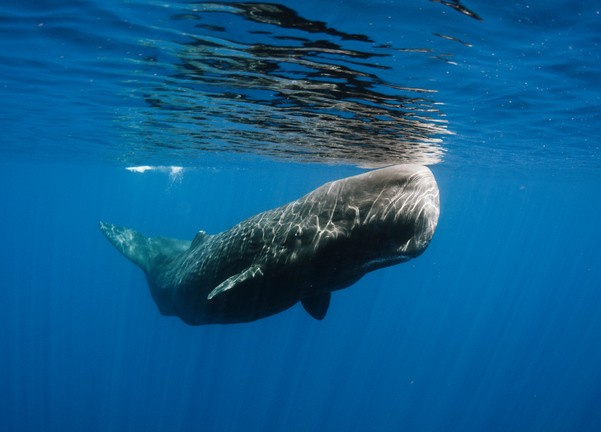Sperm Whale, Cetacean - Vertebrate
Sperm whales (Physeter macrocephalus) are known for their massive, box-shaped heads and are found in oceans across the world. These are the largest of the toothed whales. They were popularized in Herman Melville’s novel Moby Dick, and are famous for their epic battles with giant squid.

More about Sperm Whale
Habitat
Sperm whales are found in all of the world’s oceans except the polar seas. They live near the surface of the ocean but dive deep to feed.
Physical Description
Sperm whales have skin that is dark gray to black. They have huge, box-shaped heads and rounded foreheads. Their head is the largest head of any animal—it can be 20 feet (6 m) long, 10 feet (3 m) high, and 7 feet (2 m) across. This head takes up to 25 or 35 percent of the whale’s total body length.
Their mouth is lined with rows of teeth. The lower jaw has 20–26 large conical teeth. The teeth in the upper jaw, however, don’t always emerge and are considered vestigial. Some healthy whales do not have any teeth at all—it thus appears that teeth may not be necessary for feeding.
Sperm whales have 5-foot (1.5-m) long flippers that are around 3 feet (1 m) wide. They have small, rounded dorsal fins.
Sperm whales are the only cetacean that has a single blowhole asymmetrically located along the front left side of its head.
Interesting Biology
The animal’s head holds a substance called spermaceti, which is also behind the whale’s name—whalers once thought that the fluid was sperm. Scientists are still shaky on the exact purpose of spermaceti, but it’s believed to help with buoyancy.
Sperm whales also produce a waxy substance called ambergris in their lower intestines. Ambergris may help protect the whale against the stings of giant squid. Interestingly, ambergris was once valued for its sweet and earthy scent and used in perfumes.
Sperm whales sometimes dive as deep as 3,280 feet (1,000 m) to search for food. On long dives, they can hold their breath for up to 90 minutes.
The whales form groups called pods that include 15 to 20 animals. Pods typically include females and young whales. Males usually roam alone and may move amongst different pods. Males migrate to higher latitudes and then return towards the equator to breed.
Sperm whales communicate via sounds and also use echolocation for navigation. They have a huge brain that can weigh up to 20 pounds (9 kg)—the largest of any animal, but compared to their body size, the brain is not exceptionally big. These whales also have a four-chambered heart that can weigh up to 277 pounds (126 kg).
Diet
Sperm whales are carnivores that eat thousands of pounds of fish and squid—approximately one ton (907 kg) each day.
Height/Weight
Adult males range from 50 to 60 feet (17 to 20 m) and weigh 35 to 45 tons (30.8 to 41.8 tonnes). Females are smaller—they range from 33 to 40 feet (11 to 13 m) and weigh 14 to 18 tons (12 to 16 tonnes).
Brief Taxonomy
Order: Cetacea.
Family: Physeteridae.
Sources
Perrin, WF, Wursig, B, Thewissen JGM, eds. 2002. Encyclopedia of Marine Mammals. Academic Press.
Similar Profiles
We believe travel is more than ticking destinations off a list – it’s about discovering new places deeply, feeling connected wherever you go, and knowing you have a trusted team behind you every step of the way.



